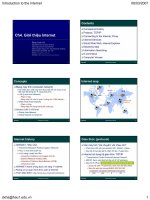Tài liệu Speaking to the Spirit World doc
Bạn đang xem bản rút gọn của tài liệu. Xem và tải ngay bản đầy đủ của tài liệu tại đây (227.78 KB, 17 trang )
Hmong Studies Journal
v2n2 Spring 1998
The Hmong Qeej: Speaking to the
Spirit World*
Gayle Morrison
Abstract
This investigation focuses on the unique communicative
ability of the Hmong
qeej
, a free-reed multiple pipe musical
instrument. Other forms of the
qeej
are used by various
Southeast Asian cultures, but only the Hmong appear to use it
to communicate in words with the spirit world.
This study is based on oral interviews with Hmong
qeej
players, focusing on one master
qeej
player. Discussion
reviews the origin legend of the
qeej
, legendary powers of
the instrument, the mystery of the
qeej
language, training of
a
qeej
player, qualifications of a master
qeej
player, genre
of
qeej
songs, the role of the
qeej
in the funeral ceremony,
and the
qeej
as the consumate Hmong cultural identifier.
Editor's Note: The photo essay "Por Thao's Funeral" by Joseph
Davy, in this issue, contains several photos of the
qeej
being played.
[1]
It is not only in Southeast Asia that music plays a part in
discourse with the spiritual. The sacred realm is accessed
through music in many cultures. Through the use of rhythm,
tone, pattern repetition, melody and scale, the relationship
between the natural and supernatural worlds can be explored.
In this article I would like to consider some of the
relationships between the function and form of sacred
language, music, and ceremony by examining these aspects vis-
a-vis the Hmong
qeej
("kheng").
Page 1 of 17Hmong Studies Journal
5/21/2004 />[2]
The Hmong
qeej
generally is described by musicologists as a
free-reed multiple pipe musical instrument. It is a solo
instrument, played without the accompaniment either of other
musical instruments or singing, although it is intermittently
accompanied by drums at a funeral. The
qeej
pipes are played
horizontally and the overall length of the instrument varies
from two to five feet, depending on the skill and the
preference of the player. Many Southeast Asian ethnic groups
have pipes that appear to be quite similar to the Hmong
qeej
,
such as the Lao/Thai
khene
and the Khumu
s'qkuul
, and on this
basis it is generally assumed that they function similarly
within their respective communities, i.e., they make music.
But this assumption is based on a loose similarity of form,
furthered by geographical proximity. To the Hmong, the
function of the
qeej
is unique to their culture and any
similarity of form found between the
qeej
and musical
instruments of other Southeast Asian cultures is not
pertinent and is, in fact, misleading.
The Hmong
Qeej
.
Page 2 of 17Hmong Studies Journal
5/21/2004 />[3]
For the Hmong, the indisputable difference between their
instrument and those of other ethnic groups is that the Hmong
qeej
"speaks." To the Hmong, the
qeej
is not an instrument
designed to produce music; it is a bamboo voice that intones
a highly stylized and ritualistic language. Thus "music' and
"speech" are inseparable.
[4]
The
qeej
is an instrument that communicates with the spirit
world. However, unlike most sacred instruments, it is neither
mimetic of the sounds and rhythms of the natural world nor
does it communicate in symbolic or metaphoric terms. It is an
unusual instrument because of its ability to express
musically the innate lyrical qualities of the tonal Hmong
language.
[5]
Before beginning the body of this article, I would like to
tell you the legend of the origin of the
qeej
as it was told
to me by Mr. Nhia Dang Kue of Stockton, California, a master
qeej
player. A number of oddities appear in this legend and
the audience is left at the end with more than a few
questions in mind. In retrospect, the legend may appear more
like an elaborate setting for the storyteller to introduce
the names of the seven pipes of the
qeej
rather than the
origin of the instrument since so many questions about the
origin are left unanswered.
[6]
Long ago, there was a god-man by the name of Sinsay. Sinsay's
talent lay in his strength as a great warrior and he eagerly
engaged in combat to prove it. Many challenges took place
with Sinsay always the victor, and his reputation as a
champion quickly spread
[7]
If Sinsay won a challenge, which he always did, his prize was
to marry one beautiful young woman from that kingdom. There
would be a brief honeymoon, then he was off again in search
of another kingdom to conquer. Eventually, Sinsay conquered
Page 3 of 17Hmong Studies Journal
5/21/2004 />seven kingdoms and married seven brides.
[8]
At about the same time as Sinsay's seventh marriage, the god-
king decided to have a grand festival. Everyone was invited
and preparations for it began months in advance. Excitement
was high, especially for the seven young wives Sinsay had
left behind in the care of their families. Each of them,
knowing he would be at such a festival, made her own plans to
find her husband and be reunited with him. Sinsay too had
heard of the festivaL He looked forward to attending it and
claiming his champion status; he also looked forward to
finding his seven wives, all of whom he was sure would be
there.
[9]
The opening day of the fair finally arrived, bringing
together thousands of people. Sinsay and each of his wives
anxiously searched throughout the fairgrounds to find each
other. But it had been so long since he had been with any of
them that neither Sinsay nor his wives could recognize one
another. Disappointed but unwilling to give up the search,
each wife began to sing her own
lug txaj
, love songs about
the details of their life together that only a husband or
wife would know. And so, one by one, Sinsay found his wives
because of their
lug txa
j. And, one by one, he sang
lug txaj
back to the women, acknowledging each of them to be his wife.
[10]
Although a champion warrior, Sinsay was unable to allay the
outrage and wrath of the seven women when they found out that
he had married seven times. A heated argument broke out as
each of the women shouted, "He's mine!" The situation got so
bad that it came to the attention of the festival host, the
god-king himself
[11]
The god-king intervened and asked, "What is the problem?" All
seven wives shouted, "He's my husband!" The god-king thought
for a moment then told the women, "If all seven of you say
that each of you are his wife, then each of you must go and
make something so that when all seven parts are put together
into one thing, words will come out of it. If it is your
destiny to be his wives, then you will be able to make
something that speaks. If you cannot do this, your claim is
Page 4 of 17Hmong Studies Journal
5/21/2004 />not true." So each of the women went off to make something.
The first wife made a pipe we call
taub qeej
.
The second wife made a pipe we call
ntiv lauv
.
The third wife made a pipe we call
ntiv tw
.
The fourth wife made a pipe we call
ntiv npug
.
The fifth wife made a pipe we call
ntiv txug
.
The sixth wife made a pipe we call
cej ntiv npug
.
The seventh wife made a pipe we call
cej ntiv txug
.
[12]
When all the women gathered again with Sinsay and the god-
king, the seven pipes were put together into one instrument
and when it was blown it made words. Then the god-king
declared that all of the women were Sinsay's true wives.
[13]
The legend of the
qeej
is provocative, with several curious
leads that are not resolved. For example, one suspects that
the seven wives and the seven pipes have more than a
coincidental relationship. Are the names of the pipes also
the names of the wives? Do the pipes have discreet "voices"
that are associated with the separate personalities of the
wives? I asked Mr. Nhia Dang Kue these questions and he
assured me there was no connection whatsoever. The names of
the pipes are the names of finger and pipe positions and the
single "voice" of the
qeej
is made from a blending of the
multiple pipe tones; it is not several separate voices played
together. Another question that comes to mind is why, except
for the Hmong in China, the instrument is played now
exclusively by men when it was invented by women. Many
questions remain, calling for further investigation.
[14]
In the body of this article, I would like to follow up on two
particular aspects of the
qeej
instrument. The first aspect
is the mystery of the language. In this section I will look
Page 5 of 17Hmong Studies Journal
5/21/2004 />at some of the characteristics of common Hmong speech and the
sacred language of the
qeej
. The second aspect is to delve
further into the use of the
qeej
in the Hmong funeral
ceremony. Regarding this, it is interesting to note that the
qeej
is most often associated with the funeral ceremony even
though the legend of the
qeej
places its origin at a festival
or a big fair, something that will be mentioned again later.
Language
[15]
Although exceedingly different from English in structure,
Hmong is a simple language and almost all Hmong words are
monosyllables that contain consonants, vowels, and one of
seven tones. Spoken Hmong is a richly inflectional and
intonational language. These qualities go far to explain why
the pipes are able to imitate the spoken language. According
to the Barney-Smalley RPA (Roman Popular Alphabet) sound
system for the Hmong language, the seven tones or pitches are
described as high, high falling, mid rising, mid, low, low
breathy, and short low with an abrupt end (William A.
Smalley, ed.
Phonemes and Orthography; Language Planning in
Ten Minority Languages of Thailand
, Canberra, Australia:
Linguistic Circle of Canberra, 1976). Each of these tones can
be replicated on the Hmong
qeej
along with all of the Hmong
vowel sounds. Consonants, however, cannot be pronounced by
the
qeej
. The reedy mimicry of vowels, tones, inflection, and
rhythm, without the consonants, heightens the mystery of the
language.
[16]
Perhaps the mention of seven tones has caught your ear and
you are wondering if there is a direct correspondence between
the seven pipes and the seven tones. The symmetry of sevens
would be pleasing, but again there is no connection. First of
all, only six of the pipes are playing pipes. Second, all of
the pipes are used in various combination in order to create
a single tone-word.
[17]
According to legends known primarily by
qeej
players, the
qeej
originally had powers far beyond a speaking voice. The
Page 6 of 17Hmong Studies Journal
5/21/2004 />









